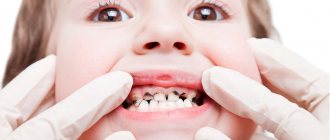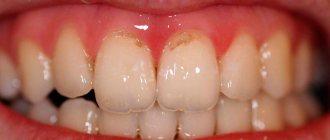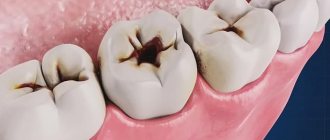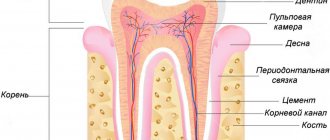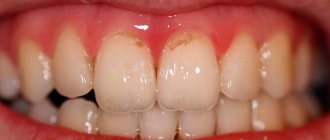According to statistics, by the age of six, approximately 70% of children have dental caries. A large percentage of young children are susceptible to developing so-called bottle caries. What kind of disease is this, why it occurs and whether it can be cured, we will tell you in the article.
In this article
- The mechanism of caries development in children
- What is bottle caries in children?
- How to treat bottle caries?
- How bottle caries is treated using remineralization method
- Treatment of bottle caries using fluoridation
- Treatment of bottle caries using the ICON method
- Is silver plating safe for children?
- Ozone therapy treatment
- What to do if there is a hole in your tooth?
- What should be done to prevent bottle caries?
The mechanism of caries development in children
Caries is a slowly occurring pathological process in which the destruction of hard dental tissues occurs. It can affect both baby and permanent teeth and occurs in adults and children of any age.
It is known that caries develops under the influence of several factors - both external and internal. The main cause of carious lesions is the activity of cariogenic bacteria. They coat the teeth with a biofilm we call plaque. Bacteria feed on carbohydrates that enter our body with food. They ferment sugars and convert them into acids, which have a negative effect on superficial and deep dental tissues. If plaque is not removed from the surface of the enamel in time, the acids will destroy its structure and sooner or later penetrate into the dentin - the bone tissue under the enamel. Thus, it is organic acid, a product of bacterial activity, that has a damaging effect on teeth.
There are factors that increase the risk of developing caries. These include:
- a large amount of carbohydrate and sweet foods in the diet;
- multiple snacks, keeping food in the mouth for long periods of time (for example, sucking on lollipops, bottle-feeding babies at night);
- infrequent or improper brushing of teeth, which does not effectively remove plaque;
- a diet lacking healthy foods rich in calcium and fluoride.
Symptoms of the disease
Clinical manifestations are directly dependent on the neglect of the pathological process. At first, the upper incisors and canines suffer, since they are actively involved in sucking the breast or bottle and come into contact with milk.
The disease begins with damage to the area where the coronal part adjoins the gums, which are least protected from negative effects. Then the entire crown is damaged.
At the very beginning, barely noticeable whitish spots appear on the teeth. Then they darken, and the baby experiences discomfort when eating. In the later stages of development of the pathology, the teeth are destroyed to the ground, and acute pain is noted.
What is bottle caries in children?
Childhood caries can occur for various reasons. One of the most common forms of the disease does not occur in adults, but is characteristic of young children. This is the so-called baby bottle caries. Another name is circular. What are its features and reasons?
The main cause of bottle caries can be understood from the name - long-term feeding of a child from a baby bottle with a pacifier. The disease is also typical for children who have been breastfed for a long time.
The essence of the problem is as follows. When a baby is given a bottle and breastfeeding before bedtime or nap time, baby's teeth are left with large amounts of sweet carbohydrates, a food source for bacteria. At the same time, at night the amount of saliva in the mouth decreases, which has a bactericidal effect and could at least partially protect the teeth. It turns out that all night or several hours during the day, while the child is sleeping, there are food remains in the oral cavity, which microbes happily convert into acid. At the same time, the enamel of children's teeth is not yet as strong as that of adults. Therefore, caries begins and spreads much faster. In just a few months or even weeks, it can go from early stage staining to deep dentin damage.
The peculiarity of bottle caries is that most often it affects the front incisors: whitish spots appear on them in the contact areas and near the gums. This is due to the peculiarities of gripping a bottle or the mother's breast when feeding. The circular arrangement of bottle dental caries on the front teeth, in areas of contact with food, gave it the name circular. This type of caries is often diagnosed in a one-year-old child who continues to eat from a bottle, although he can receive complementary foods from a spoon. In addition to babies of the first year of life, children's bottle caries can appear in two- and three-year-olds, who are allowed to eat sweets and drink juices more than three times a day. The mechanism of dental damage is the same as with bottle feeding.
Causes of the disease
The main reasons for the development of bottle caries are the same as those characteristic of other types of carious lesions: damage and further destruction of dental tissue under the influence of acids produced by bacteria multiplying in the oral cavity. The food for these bacteria is mainly carbohydrate residues that settle on the teeth after feeding. But the reasons for the presence of such food debris in the mouth and the inability of the body to suppress the activity of bacteria are secondary and have different effects on the risk of developing bottle caries.
<
On a note
As a rule, bottle caries occurs in children with reduced immunity and various concomitant pathologies, but there are frequent cases of its development in healthy children due to the defective tissue structure of the enamel and other factors that cause caries. These include mainly incorrect feeding regimen and lack of proper oral hygiene after it. Remains of food after feeding (especially at night) with weak salivation and (or) insufficient mineral content of saliva allow the microorganisms of plaque that forms on the teeth to quickly lead to tooth destruction.
Most dentists believe that the main reason for the development of bottle caries is night feeding of the child. And it doesn’t matter whether the baby eats from a bottle or suckles - lactose (milk sugar) is found in both formula and breast milk, and it is also an ideal substrate for the development of bacteria.
But this reason in itself does not always lead to the onset of the disease: in many cases, children who are fed at night do not develop caries. And, on the contrary, in some young patients, signs of bottle caries appear even with a clear feeding schedule with the last meal before bed and brushing the teeth after it.
<
Therefore, other reasons also play an important role in the occurrence of bottle caries:
- Weakened immunity and insufficient bactericidal properties of the child’s saliva: in normal cases, the child’s body’s own defenses should be sufficient to suppress the activity of bacteria in the mouth. In children who (or who) do not brush their teeth, eat at night and do not have caries, it is saliva that protects teeth from decay. The opposite statement is also true: if the ability of saliva to resist bacteria is less pronounced, then teeth can be affected even with high-quality oral hygiene. At the same time, other diseases of the body can affect the decrease in the bactericidal qualities of saliva - for example, diabetes, influenza, and intestinal infection. In any case, the child can be weaned from night feedings and teeth can be properly brushed. In such conditions, the development of caries will be significantly slowed down, and attentive parents will always have time to show their child to the dentist when the tooth can still be saved and left unharmed.
- Mistakes in planning your baby's diet. Sweets, sweet cereals and juices, confectionery and flour products, the remains of which linger on the teeth, most contribute to the reproduction and prosperity of microflora in the mouth. The condition of teeth is also affected by a lack of rough food: carrots, apples, which, when chewed, erase plaque. There may also be a lack of foods high in calcium and phosphorus in the diet - fish, natural dairy products.
- A regional factor may also have an effect: if there is a lack of fluoride in drinking water, tooth enamel is weakened and more quickly damaged by aggressive acids.
<
<
It all starts with ordinary zones of focal demineralization or spots in the cervical area, and then the destruction that has begun can turn into a severe form of cervical caries - circular caries, up to the breaking off of part or the entire tooth crown. At the same time, teeth may not hurt for a long time due to the protective ability of them to form replacement dentin, which saves from accidental opening of the pulp (“nerve”).
If treatment is not started in time, the consequences of bottle caries can be very serious. No one knows exactly on what day the pain from decaying teeth will begin, but it is at the most inopportune moment that the baby will refuse to eat normally and even sleep.
<
Multiple extractions of primary teeth result in malocclusion. Carious infection, inflammation, premature removal of baby teeth - all this directly or indirectly affects the normal development and eruption of permanent teeth. In order to prevent such terrible consequences, it is necessary to promptly treat caries even on baby teeth, without justifying inaction by saying that they will soon fall out.
<
In general, proper oral hygiene is always important - a bottle of milk before bed will be less harmful to the teeth if the child's teeth are brushed after feeding.
Heredity is also considered to be the cause of bottle caries, but in the vast majority of cases, parents use heredity to justify their laziness and reluctance to brush their child’s teeth or teach him to do it himself. Remember: even if you have a genetic predisposition, proper oral hygiene and a healthy diet will significantly reduce the likelihood of developing caries!
<
At the earliest stages, bottle caries can appear in the form of light matte spots (the stage of a white or chalky spot), which over time take on the appearance of roughness on the enamel, gradually deepening and darkening.
Next in the photo is a medium-sized caries that has affected several teeth at once. Such simultaneous damage is a characteristic diagnostic sign of bottle caries:
<
As a rule, bottle caries first affects the front upper four teeth of a child. The carious process often begins in the gingival zone, quickly covers the perimeter of the entire tooth above the gum and penetrates into the deep layers of enamel. Damage to the gingival zone of the tooth is a characteristic feature of bottle caries.
Generally speaking, deep bottle caries indicates an irresponsible attitude of parents towards the child’s health: it is easy to notice the pathology in the early stages, and only parents who pay attention to the child’s teeth only when he constantly complains can bring a child with teeth half eaten away by caries to the clinic.
<
Important!
Bottle caries can develop not only on several front teeth at once, but also on one single tooth and on molars. Therefore, the child should regularly and carefully examine all of his teeth, not just the front ones.
How to treat bottle caries?
Treatment of children with bottle caries is carried out using different methods, depending on the age of the child, the stage of development of the disease, and the technical capabilities of the dental clinic. There are two main approaches to treatment - conservative and surgical. The first involves treatment without preparation, drilling the tooth with a drill, or installing a filling. These are non-invasive and completely painless methods. But, unfortunately, they are effective only in the early stages.
Much more often it is necessary to carry out surgical treatment, in which the tooth is opened and a filling is installed. This is due to the fact that in most cases, bottle caries is diagnosed too late - when the tooth already has cavities and preparation cannot be done without.
Possible complications
Bottle caries has serious consequences. Many parents believe that it is pointless to treat baby teeth, because they will be replaced by permanent ones. As a result, the disease becomes advanced. It is important to understand that the infection can affect the rudiments of molars, which will erupt with caries. In addition, the pathological process on one milk tooth quickly spreads to the rest, and multiple caries appears. The infection can deepen, affecting the pulp (neurovascular bundle of the tooth) and peri-root tissue. As a result, the disease leads to premature loss of baby teeth, malocclusion, and impaired eruption of permanent dentition.
How bottle caries is treated using remineralization method
Early bottle caries can often be found on the teeth of children aged 10-20 months. Signs of carious lesions at this stage are white spots on the enamel and in the area of contact of the dental crown with the gum and adjacent jaw. A small child does not show any signs of anxiety, because teeth with early caries do not hurt or cause discomfort. To notice the lesion, parents should regularly examine the baby’s mouth and, if they detect changes in the enamel, immediately contact the dentist.
For early caries in children, treatment will consist of strengthening the enamel, restoring its mineral composition and stopping further pathological process.
There are different options for treating caries without a drill. One of the methods is remineralization therapy. The mineral composition of tooth enamel consists of 57% calcium and phosphorus. When these substances are not enough, gradual destruction of the enamel structure occurs. Retherapy is carried out to restore its normal mineral composition and strength. For the purpose of remineralization, the surface of the teeth is covered with gels, pastes and other preparations with calcium and phosphorus. To consolidate the result, the dentist may prescribe additional fluoride-containing medications. They reduce the solubility of tooth enamel, prevent the leaching of calcium, and increase its resistance to acid.
In order for retherapy to give the expected result, a number of conditions must be met. Firstly, remineralizing compounds are applied only to teeth that have been cleaned of plaque, because they must come into contact with the enamel. Secondly, the contact must be long-lasting. Thirdly, minerals must be present in them in the form of phosphorus and calcium ions.
Correct retherapy, which will give the best results in the treatment and prevention of bottle caries, can be carried out by a qualified dentist.
Features of prevention
You can prevent bottle caries in children by following the following recommendations:
- careful implementation of hygiene measures: it is important to brush your teeth from the moment the first lower incisors appear;
- timely visits to a pediatric dentist or hygienist;
- compliance with the feeding regime, gradual abandonment of night feedings;
- diet correction: avoidance of large amounts of carbohydrates, preference for fresh vegetables, fruits, fish, meat, herbs.
Doctors at STOMA clinics are proficient in modern methods of treating bottle caries. You can bring your child to us for both a preventive examination and treatment. In our work we use advanced equipment and high-quality materials.
Treatment of bottle caries using fluoridation
A disease such as bottle caries can be cured at an early stage using simple or deep fluoridation.
The essence of fluoridation is that tooth enamel is saturated with fluoride - a substance that reduces tooth sensitivity, strengthens the enamel, and makes it less susceptible to negative external influences.
With simple fluoridation, a fluoride-containing composition is applied to the teeth, which forms a thin protective film. With deep fluoridation, in addition to fluorine, the preparations include calcium and other compounds. Their complex action promotes the penetration of beneficial substances into the enamel structure and strengthens it from the inside.
After fluoridation, teeth become less sensitive, the surface of the tooth enamel becomes smoother, less plaque accumulates on the teeth, and light and dark spots disappear.
Treatment of bottle caries using the ICON method
Children over three years old with early stages of caries can be treated with a minimally invasive infiltration method. It is absolutely safe, but requires sitting still for about 20 minutes, so is not suitable for younger children.
The essence of the ICON method is that after preliminary preparation, damaged tooth enamel is coated with a sealant gel. It penetrates the pores of the enamel, seals them and prevents bacteria and acid from penetrating deep into the tooth.
Is silver plating safe for children?
The superficial form of bottle caries most often occurs in children between 16 and 24 months. At this stage of the lesion, dentin is exposed - the hard tissue of the tooth located under the enamel, the enamel becomes more sensitive. Gradually, carious spots change shade: instead of light, they become dark. Caries at this stage is also treated with remineralizing therapy, fluoridation, and infiltration. In some cases, it is advisable to carry out silvering.
Although this method is considered outdated and has a negative impact on the aesthetics of teeth (they darken), silver plating is still used in pediatric dentistry.
The essence of the method is that the surface of the teeth is coated with silver nitrate. It forms a film on the teeth that has an antimicrobial effect. Silvering does not cure bottle caries, but it can stop its development for a certain period of time.
What to do if there is a hole in your tooth?
The above methods will help cure caries in the initial stage, when there is no cavity in the tooth. As soon as a hole has formed in the dentin, this means that caries has entered the medium or deep stage. In this case, treatment is carried out surgically.
The affected teeth are prepared, cleaned, dried, the cavity is prepared for the installation of a filling, and then filled with modern composite materials.
Children of any age do not like to visit dentists; some of them are difficult to even sit in a dental chair, let alone carry out treatment with a drill. This is why early diagnosis is so important, which is only possible with regular visits to the dentist.
What should be done to prevent bottle caries?
The development of bottle caries can be avoided if you monitor children’s teeth from early childhood and take comprehensive preventive measures:
- Teeth brushing begins immediately with the eruption of the first tooth. In the first year, you should use a soft brush without toothpaste or with a small amount of children's toothpaste. After a year, teeth are brushed with toothpaste; dentists also recommend using dental floss.
- In order to prevent tooth decay, you should not bottle feed your baby for a long time. When introducing complementary foods, it is advisable to immediately teach the baby to eat with a spoon from a plate. A similar recommendation applies to those children who are bottle-fed.
- Do not feed children before bed or during the day, and do not leave bottles in the crib for the baby to suck on throughout the night.
- Instead of sweet drinks, introduce your child to clean water and unsweetened tea.
- To avoid the transfer of cariogenic bacteria from an adult to a child, you should not share a spoon with children or give a child a pacifier from your mouth.
- In order to promptly notice pathological changes in the structure of the enamel and the condition of children's teeth, visit the dentist at least once every six months, even if it seems that the child has no signs of caries.
- Dental caries in children develops rapidly, and it is better for the dentist to once again confirm the healthy state of the oral cavity than to immediately detect pulpitis.
These simple recommendations will protect children's teeth from bottle caries and help maintain a beautiful smile.
Diagnostics
Bottle caries is diagnosed by a pediatric dentist during a visual examination using a mirror and probe. A specialist can determine the disease at the chalk stain stage by drying the tooth surface, stomatoscopy in UV light, and also by using vital staining of the enamel.
There are several main criteria for diagnosing bottle caries:
- the child's age is less than 3–4 years;
- night breastfeeding or bottle feeding;
- damage to the upper incisors, canines;
- Poor oral hygiene: irregular or incorrect procedures.
In some cases, an x-ray is additionally required to make a diagnosis. It allows you to assess the depth of tooth damage and detect complications such as periodontitis or pulpitis. If the doctor has reason to suspect enamel hypoplasia or other types of caries, a differential diagnosis is carried out.



